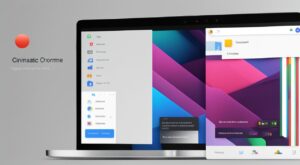Google Bard is a groundbreaking innovation in the world of technology. It is an AI-powered chatbot developed by Google that is set to revolutionize the way we access information. With its advanced language model and generative AI capabilities, Google Bard promises to provide a more intuitive and natural search experience for users. By understanding the context and intent behind users’ questions, it eliminates the need for exact keywords and delivers real-time information. This marks an important milestone in the integration of AI in search and showcases the potential for chatbots to transform the information retrieval process.
- Google Bard is an AI-powered chatbot that revolutionizes information retrieval.
- It uses advanced language models and generative AI to provide a more intuitive search experience.
- By understanding context and intent, Google Bard eliminates the need for exact keywords.
- Chatbots like Google Bard have the potential to transform the digital landscape and the way we access information.
Experience Seamless Conversations with Google ChatGPT Today!
Understanding the Power of Google Bard
Google Bard is built upon Google’s Language Model for Dialogue Applications (LaMDA), which was unveiled two years ago. This advanced language model allows Google Bard to comprehend the nuances of context, syntax, and semantics, enabling human-like interaction. What sets Google Bard apart is its use of generative AI, which allows for creativity, adaptability, and interactive collaboration. By understanding the context, Bard can craft responses that resonate with the underlying theme or emotion of the conversation. This makes it more than just a typical chatbot, as it can brainstorm ideas, develop plans, find solutions, and even create content.

With its powerful language model, Google Bard has the ability to understand natural language queries, removing the need for exact keywords. This user-friendly approach aligns with Google’s vision to enhance the search experience and provide more relevant and accurate information. By grasping the intent behind queries, Bard can deliver real-time responses that cater to the user’s needs. Whether it’s generating personalized recommendations, answering complex questions, or engaging in interactive conversations, Google Bard showcases the immense potential of AI-powered chatbots in revolutionizing the way we access information.
“Google Bard’s generative AI capabilities allow it to go beyond simple question-and-answer interactions. It can brainstorm ideas, develop plans, find solutions, and even create content.”
Advancing Language Models: Google Bard vs. ChatGPT
While Google Bard is a remarkable AI-powered chatbot, it is worth noting the differences between Google Bard and another notable language model, ChatGPT. Google Bard’s development is rooted in Google’s expertise in search algorithms and data handling, leveraging its vast data repositories for broad knowledge coverage. On the other hand, ChatGPT, developed by OpenAI, is trained on extensive amounts of internet text, enabling its conversational prowess and effectiveness in chatbots and writing aids.
| Google Bard | ChatGPT |
|---|---|
| Developed by Google | Developed by OpenAI |
| Leverages Google’s search algorithms and data repositories | Trained on extensive amounts of internet text |
| Suitable for diverse applications, possibly integrated with Google services | Known for its conversational prowess, used in chatbots and writing aids |
Both Google Bard and ChatGPT offer unique features and customizability, catering to different user needs and preferences. These language models are driving the innovation in AI-powered conversational agents, providing valuable resources for users across various domains.
The Evolution of Language Models: Google Bard vs. ChatGPT
Google Bard and OpenAI’s ChatGPT are two prominent language models that have made significant advancements in the field of AI. While both models are designed to understand and generate human-like text, they differ in their origins, functionality, and areas of expertise.
Origins and Development
Google Bard is developed by Google, leveraging the company’s extensive knowledge in search algorithms and data handling. It is built upon Google’s Language Model for Dialogue Applications (LaMDA), which enables it to comprehend the context, syntax, and semantics of conversations.
On the other hand, ChatGPT comes from the GPT (Generative Pre-training Transformer) series developed by OpenAI. It is trained on vast amounts of internet text and is known for its conversational capabilities and natural language understanding.
Functionality and Applications
Google Bard is designed to be versatile and suitable for various applications. With its integration into Google services, it can provide accurate and comprehensive answers by utilizing Google’s vast data repositories. It can assist with research, customer service, content creation, and more. Its focus is on delivering reliable and contextually relevant information.
ChatGPT, on the other hand, excels in conversational scenarios. It is widely used in chatbots and writing aids, as it can generate creative and coherent responses. ChatGPT is particularly useful for interactive conversation and brainstorming ideas. Its capabilities make it a valuable tool for enhancing user experience in communication-based applications.
Differences and Similarities
| Aspect | Google Bard | ChatGPT |
|---|---|---|
| Origin | Developed by Google | Developed by OpenAI |
| Training Data | Google’s vast data repositories | Vast amounts of internet text |
| Functionality | Versatile, integrated with Google services | Conversational, creative responses |
| Applications | Research, customer service, content creation | Chatbots, writing aids |
While Google Bard and ChatGPT share similarities in their ability to generate human-like text, their origins, training data, and focus areas set them apart. Understanding these differences allows users to choose the model that best suits their specific needs and applications.
Practical Applications of Google Bard
Google Bard, with its advanced AI capabilities, has a wide range of practical applications across various domains. In research, Bard can be a valuable tool for scholars, allowing them to quickly scan academic databases, translate complex jargon, and gain crucial insights for their studies. By leveraging Bard’s language model and generative AI, researchers can streamline their information retrieval process and access the most relevant and up-to-date resources.
In business processes, Google Bard has the potential to revolutionize customer service. Customer service representatives can utilize Bard to provide timely and accurate responses to customer queries, enhancing the overall customer experience. Bard’s ability to understand context and intent enables it to deliver personalized and helpful information, improving customer satisfaction and retention. Additionally, marketers can leverage Bard’s capabilities to analyze consumer trends and gather valuable insights, enabling them to make data-driven decisions for their marketing strategies.
However, it’s important to be aware of potential biases in the algorithms that power AI chatbots like Google Bard. As AI systems learn from human-generated data, they may inadvertently inherit biases present in the data. These biases can impact the accuracy and fairness of the responses generated by Bard. Organizations must be cautious and actively monitor the performance of AI systems to ensure they provide reliable and unbiased results.
| Domain | Practical Applications |
|---|---|
| Research | Quickly scan academic databases, translate complex jargon, gain insights for studies |
| Business Processes | Assist customer service representatives, analyze consumer trends, gather user feedback |
As organizations continue to explore the potential of AI, it’s crucial to strike a balance between leveraging AI technologies like Google Bard for their practical benefits while ensuring ethical use and mitigating potential biases. With careful consideration and monitoring, Google Bard and similar AI-powered systems can drive innovation, improve efficiency, and enhance the overall user experience in various domains.
Alternatives to Google Bard
While Google Bard is a groundbreaking innovation in the field of AI-powered chatbots, there are several alternatives available in the market that offer unique features and cater to different user needs. Let’s take a closer look at some of these alternatives:
1. Microsoft Turing-NLG
Microsoft Turing-NLG is a powerful language generation model that offers a wide range of applications. It utilizes advanced natural language processing techniques to generate human-like text, making it suitable for tasks such as content generation, translation, and sentiment analysis. With its robust capabilities, Microsoft Turing-NLG is a popular choice in the AI community.
2. IBM Watson
IBM Watson is a comprehensive AI platform that offers a range of analytics and deep learning capabilities. It is renowned for its ability to understand unstructured data and provide valuable insights. Businesses can leverage IBM Watson to analyze large datasets, extract meaning from complex information, and make informed decisions based on data-driven insights.
3. Amazon Lex
Amazon Lex is a chatbot building platform that specializes in creating conversational interfaces. It allows developers to easily build and deploy chatbots across multiple channels, including websites, mobile apps, and messaging platforms. With its powerful natural language understanding capabilities, Amazon Lex helps businesses provide enhanced customer support and streamline interactions.
4. Facebook BlenderBot
Facebook BlenderBot is an open-domain chatbot developed by Facebook AI Research. It showcases the potential of large-scale chatbots that can engage in meaningful conversations. By leveraging vast amounts of training data, BlenderBot can provide responses that are more contextually appropriate and engaging. It is an excellent tool for conversational agents and virtual assistants.
These alternatives to Google Bard offer a diverse range of features and functionalities, catering to different user requirements. Whether you are looking for advanced language generation, deep learning analytics, conversational interfaces, or large-scale chatbots, these options provide compelling alternatives in the AI landscape.
| Alternative | Features | Applications |
|---|---|---|
| Microsoft Turing-NLG | Advanced natural language processing techniques | Content generation, translation, sentiment analysis |
| IBM Watson | Analytics, deep learning capabilities | Data analysis, insights extraction, decision-making |
| Amazon Lex | Conversational interface creation | Customer support, streamlined interactions |
| Facebook BlenderBot | Large-scale chatbot, contextual responses | Conversational agents, virtual assistants |
The Future of Google Bard
As Google Bard continues to redefine the way we access information, its future holds exciting possibilities. One of the key advancements being developed is multilingual support, which will make Bard accessible to users worldwide. By expanding its language capabilities, Google Bard will be able to serve a more diverse range of users and cater to a global audience. This expansion will open up new opportunities for communication and knowledge-sharing across different cultures and languages.
Another intriguing development on the horizon is the integration of visual elements into Bard’s responses. By incorporating images, videos, and other visual media, Bard will enhance the user experience and provide a richer and more immersive search environment. Visual cues can help users better understand complex concepts, explore ideas, and engage with the information in a more meaningful way. This integration of visual elements will further bridge the gap between human-like interaction and AI-driven technology.
Google is also working towards integrating Bard into existing platforms and systems, making it seamlessly compatible with various applications. This integration will enable businesses, researchers, and individuals to leverage Bard’s capabilities within their existing workflows and systems. By seamlessly integrating with popular tools and platforms, Bard will become an integral part of everyday communication and information retrieval, transforming industries and enhancing efficiency.
While Google Bard is currently free, there may be future pricing models introduced to sustain its growth and integration into diverse platforms. As Bard becomes more widely adopted and integrated across a range of applications, a sustainable pricing model will ensure its continued development and support. Google will carefully consider the value Bard brings to its users and the costs associated with its maintenance and improvement, striking a balance between affordability and sustainability.
| Feature | Benefits |
|---|---|
| Multilingual Support | Accessible to users worldwide, fostering global communication and knowledge-sharing |
| Integration of Visual Elements | Enhanced user experience with visual cues, improved comprehension, and engagement |
| Integration into Existing Systems | Seamless compatibility with popular platforms, facilitating effortless adoption and utilization |
| Pricing Models | Sustainable pricing to support growth, development, and continued user support |

Conclusion
Google Bard, the AI-powered chatbot developed by Google, has the potential to revolutionize the way we search for information. With its advanced language model and generative AI capabilities, Bard provides an intuitive and user-friendly search experience.
As the field of AI continues to advance, language models like Google Bard play a crucial role in shaping the future of search. These innovations offer a glimpse into the transformative power of AI technology in the digital landscape.
Embracing the possibilities of Google Bard and similar AI advancements allows us to unlock the full potential of technology. With its ability to understand context, generate creative responses, and adapt to user needs, Google Bard represents a significant step forward in the evolution of search.
FAQ
What is Google Bard?
Google Bard is an AI-powered chatbot developed by Google that revolutionizes the way we access information.
How does Google Bard work?
Google Bard uses an advanced language model and generative AI capabilities to understand the context and intent behind user queries, providing real-time information without the need for exact keywords.
What is the difference between Google Bard and OpenAI’s ChatGPT?
Google Bard leverages Google’s expertise in search algorithms and data handling, while ChatGPT is known for its conversational prowess and is trained on extensive internet text.
What are the practical applications of Google Bard?
Google Bard can be used in research to quickly scan academic databases, assist customer service representatives, help marketers analyze consumer trends, and gather user feedback for product developers.
Are there any alternatives to Google Bard?
Yes, alternatives include Microsoft Turing-NLG, IBM Watson, Amazon Lex, and Facebook’s BlenderBot, each with its own unique features and strengths.
What does the future hold for Google Bard?
Google is working on expanding Bard’s language support, incorporating visual elements into its responses, and integrating it into existing platforms and systems. Future pricing models may also be introduced.
How is AI revolutionizing the tech world?
AI innovations like Google Bard are enhancing our daily lives by transforming the way we access information, providing greater convenience and efficiency.
























+ There are no comments
Add yours